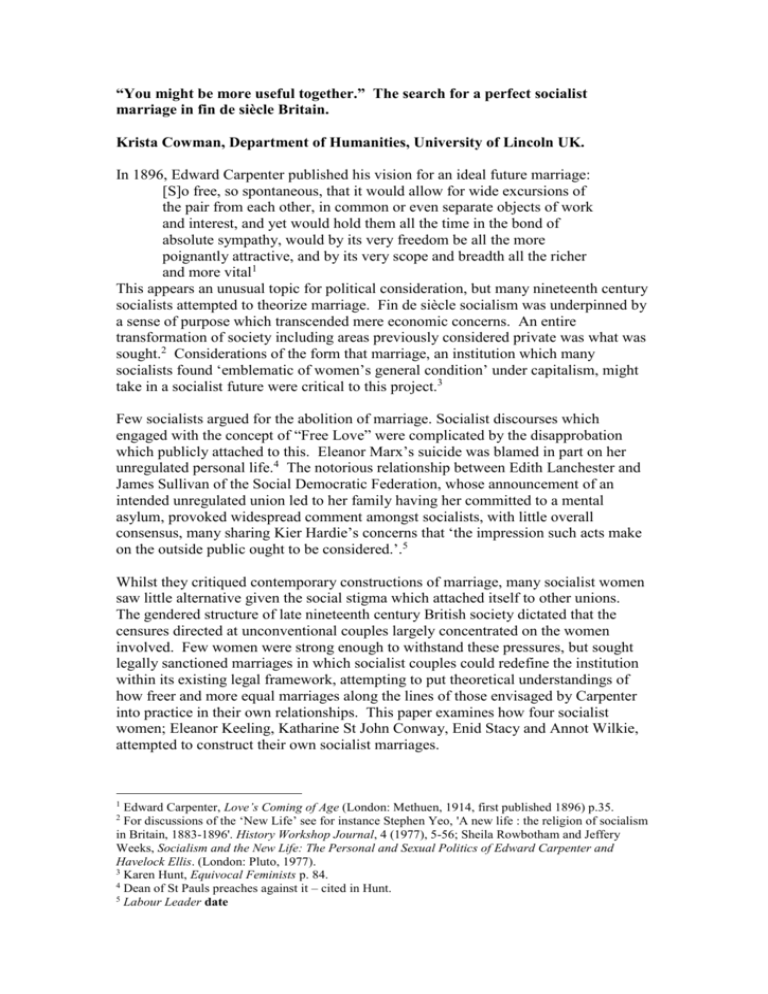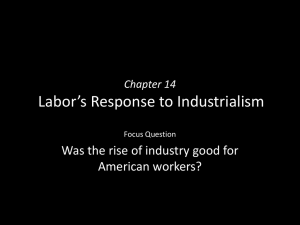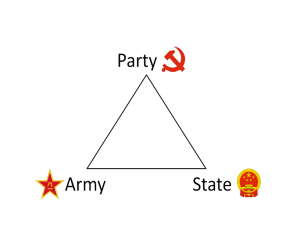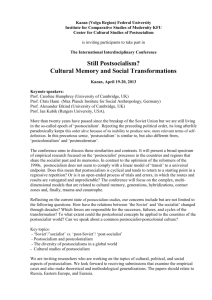The search for a perfect socialist marriage in fin de
advertisement

“You might be more useful together.” The search for a perfect socialist marriage in fin de siècle Britain. Krista Cowman, Department of Humanities, University of Lincoln UK. In 1896, Edward Carpenter published his vision for an ideal future marriage: [S]o free, so spontaneous, that it would allow for wide excursions of the pair from each other, in common or even separate objects of work and interest, and yet would hold them all the time in the bond of absolute sympathy, would by its very freedom be all the more poignantly attractive, and by its very scope and breadth all the richer and more vital1 This appears an unusual topic for political consideration, but many nineteenth century socialists attempted to theorize marriage. Fin de siècle socialism was underpinned by a sense of purpose which transcended mere economic concerns. An entire transformation of society including areas previously considered private was what was sought.2 Considerations of the form that marriage, an institution which many socialists found ‘emblematic of women’s general condition’ under capitalism, might take in a socialist future were critical to this project.3 Few socialists argued for the abolition of marriage. Socialist discourses which engaged with the concept of “Free Love” were complicated by the disapprobation which publicly attached to this. Eleanor Marx’s suicide was blamed in part on her unregulated personal life.4 The notorious relationship between Edith Lanchester and James Sullivan of the Social Democratic Federation, whose announcement of an intended unregulated union led to her family having her committed to a mental asylum, provoked widespread comment amongst socialists, with little overall consensus, many sharing Kier Hardie’s concerns that ‘the impression such acts make on the outside public ought to be considered.’.5 Whilst they critiqued contemporary constructions of marriage, many socialist women saw little alternative given the social stigma which attached itself to other unions. The gendered structure of late nineteenth century British society dictated that the censures directed at unconventional couples largely concentrated on the women involved. Few women were strong enough to withstand these pressures, but sought legally sanctioned marriages in which socialist couples could redefine the institution within its existing legal framework, attempting to put theoretical understandings of how freer and more equal marriages along the lines of those envisaged by Carpenter into practice in their own relationships. This paper examines how four socialist women; Eleanor Keeling, Katharine St John Conway, Enid Stacy and Annot Wilkie, attempted to construct their own socialist marriages. Edward Carpenter, Love’s Coming of Age (London: Methuen, 1914, first published 1896) p.35. For discussions of the ‘New Life’ see for instance Stephen Yeo, 'A new life : the religion of socialism in Britain, 1883-1896'. History Workshop Journal, 4 (1977), 5-56; Sheila Rowbotham and Jeffery Weeks, Socialism and the New Life: The Personal and Sexual Politics of Edward Carpenter and Havelock Ellis. (London: Pluto, 1977). 3 Karen Hunt, Equivocal Feminists p. 84. 4 Dean of St Pauls preaches against it – cited in Hunt. 5 Labour Leader date 1 2 Despite sharing political values with their chosen spouses, the women felt uncertainties about embarking on marriage. They attempted to find ceremonies which signalled both formality and difference from more conventional weddings. Religious weddings conducted by the established Anglican Church remained the norm in Britain. Enid Stacy had one (her fiancé was an Anglican ordinand) but insisted in replacing the word ‘obey’ with ‘serve’ in the order of service. Katharine St John Conway and John Bruce Glasier opted for marriage in his native Scotland where different laws permitted a more simple declaration before witnesses. Eleanor Keeling and Joseph Edwards married in the local registry office with Clarion editor Robert Blatchford as witness, although Eleanor had some concerns about this and sought the opinion of her friend Annie, who replied ‘Of course you will not be married in a Church!’ Keeling was also concerned about some of the other outward symbols of marriage including her ring, but Annie reasurred her that it was ‘little more than the blue ribbon of the temperance people.’6 The women felt that much that was distinctive and socialist about their marriages was connected to their work for socialism and how best it could be furthered. “You might be more useful together” Eleanor Keeling’s friend reminded her. 7 The marriage between Sam Robinson and Annot Wilkie took many of their friends by surprise. As Emmeline Pankhurst wrote, they had ‘come to regard [Sam] as not a marrying man.’ Yet friends were positive of the news. Mrs Pankhurst was keen to have Annot working in Manchester socialist feminist circles and felt Sam to be: very fortunate. There is no woman I know for whose character and striking qualities I have a higher regard. There is no doubt that Miss Wilkie will do her part to make your …one of the few happy marriages….May you both be very happy.8 “The ILP was their love in life” their daughter Helen remembered later. 9 Katharine Bruce Glasier similarly told her husband that ‘work for the Movement [is] the reason and justification of our marriage.’10 Socialist wives sought ways to present their marriages which signalled their differences to other couples. An immediate problem was what to call themselves. Annot Wilkie became Annot Robinson, but the other women attempted to retain their own names, an extremely unconventional action at a time when there was no equivalent title to ‘Ms.’11 Enid Stacy remained Enid Stacy for public work, but became Mrs Percy Widderington in private. Katharine St John Conway attempted a similar approach, but was soon speaking and writing as Katharine Bruce Glasier.12 Eleanor Keeling retained her maiden name for all occasions. Many of her contemporaries found this difficult. When one correspondent sharply informed her that is she were neither a Miss nor a Mrs she must be a man, Eleanor suggested a revival of the term Mistress ‘as a title for grown woman’ but failed to popularise this.13 6 Annie to Eleanor Keeling, 31 January 1894, Joseph Edwards Papers, Liverpool Record Office. Ibid. 8 Emmeline Pankhurst to Sam Robinson, 15 August 1907. 9 Helen Wilson to Brian Harrison, 6 September 1981, Harrison Tapes, Women’s Library. 10 The Enthusiasts p.83. 11 On socialism and language, see Hunt, ‘Fractured Universalities.’ 12 The Enthusiasts p.83. 13 The Clarion, 13 April 1895. 7 Once they had established themselves as part of a campaigning couple, women propagandists created writings which outlined the advantages of a socialist marriage to individuals and the broader socialist movement. This was vital, not least because it was believed that many married men were being pulled away from a deeper level of activity because wives resented its capacity to take their husbands away from their homes.14 Enid Stacy’s short playlet, ‘The Labour Movement and the Home’ shows how a socialist marriage could help husband, wife and movement.15 It features two men, ‘A’ and ‘B’, who have just left a socialist meeting. B is keen to go for a drink, but A wants to return to tell his wife about how the vote has passed. B cannot understand this, as his wife sees socialism as a rival and resents how it causes her husband to neglect his home, so A explains how a socialist marriage can work. Socialist newspapers and pamphlets are read and discussed together. On Sundays, the couple take turns in minding the children and attend either to the afternoon or evening meeting. On Saturdays all go to the socialist social, possible because the club sells no alcohol. Enid concludes with her own thoughts on how marriage can inspire the movement. ‘By practise, sympathy and self-control you will succeed in making [your wife] your co-worker and your friend and she will have entered into your life because you have entered into hers.’ Parenthood placed strain on marriages where both partners wished to retain demanding levels of political activity. Each of these couples had children, but considered their decisions deeply. Enid Stacy believed motherhood ‘the most sacred of responsibilities to a socialist.’16 Her fiancé felt they were not affluent enough, and feared the impact of children on a relationship based on shared interests: You are not the woman any more than I am the man to do it. You would worry yourself old, me into an asylum, the children would end in a “home” for Clergyman’s sons....Your life and mine have heaps of interests that others have not. If you were a mother I am certain you would become narrow in your outlook……17 Enid was persuasive - their son, Gerard, was born two years later. The Glasiers faced the opposite problem. Katharine believed they should put work first and ‘like the nihilists of old….be content with spirit children’ but Bruce took the more corporeal view that ‘Women were made like women,….[to] bear sons and daughters.’ They had three, Bruce’s discussions of their decisions in his diary emphasizing the connections both felt between expanding their own family and the socialist cause.18 Annot Robinson and Eleanor Keeling also placed a political dimension on motherhood. Keeling’s first child, Fay (named after the Clarion writer) was presented to the movement at a socialist naming ceremony held on a beach at which Eleanor offered ‘a few earnest words of dedication to the cause’ on Fay’s behalf.19 Keir Hardie was godfather to Annot Robinson’s first daughter, Helen. He welcomed her with the wish that she and her parents should ‘long be spared to each other, and to the work of See Krista Cowman, ‘Giving them something to do: How the early ILP appealed to women’ in Margaret Walsh, ed, Working Out Gender. 15 Labour Prophet, March 1893. 16 Ibid 17 Percy Widderington to Enid Stacy, 7 September 1899 18 The Enthusiasts p.83. 19 Labour Leader, 29 May 1897. 14 freeing the race from bondage and superstition’ at an ILP bazaar, pinning ILP and Women’s Labour League badges onto the child in lieu of baptismal water. 20 It was very difficult for women to continue with public work involving evening meetings and speaking tours after becoming mothers. Paradoxically having equally committed husbands worsened this. Enid Stacy and Percy Widderington finally took on domestic help, although Enid was uncomfortable about the potentially exploitative nature of such arrangements, even before her son was born, forcing Percy to spell out the reality of their life as he saw it: I am sure that the thing is for you to do nothing when you are home…..it is bad for you….you do no reading and it is bad for me as I see nothing of you and you are always worrying round with the house. I am certain you can’t serve two masters. You can’t lecture and housekeep, it is wearing you out…. really reading ought to be the prime consideration with you….you have gifts as a lecturer and you ought to make use of them…21 Enid concurred, but worried about the expense.22 Her public writings remained less clear about the propriety of employing help, and argued for ‘the disappearance of the house and the substitution of the hotel or co-operative home’ as the best solution to the unequal division of domestic labour.23 The Glasiers were uncomfortable employers. They had a woman called Jennie Davies who they described as a “housefriend” rather than a servant.24 In her writings, Katharine referred to the importance of women as homemakers, and argued more for improved household technology than increased access to domestic help.25 Most chaotic of all were the arrangements of the Robinson family, where ‘Annot used to have to go and leave the dog in charge – of two children’ when Helen was a baby.26 Despite pressures, socialist marriages which succeeded were deeply happy and fulfilled. Nevertheless, this small sample also indicates that the personal costs could be prohibitively high. The toll that combining active itinerant speaking with motherhood and domestic responsibilities took on women was immense. Eleanor Keeling and Enid Stacy both died in 1903, aged 33 and 35. Katharine Bruce Glaiser survived but spend 30 years as a widow. Annot Robinson was less fortunate. Her marriage with Sam had been difficult for many years, and the couple finally separated some time around the end of the First World War which she found ‘a great emotional disappointment and disillusionment.’ Her dreams of an ideal partnership with both parties working side by side for socialism had fractured against the reality of combining the demands of two activists with those of home and family. There were suggestions that Sam, a rather nervous man with a stutter, resented Annot’s increasing 20 Hardie to Robinsons, 7 February 1911; Press cuttings from December 1911, Robinson Papers, Manchester Record Office. 21 Percy to Enid, 6 September 1899. 22 Enid to Percy 16 September 1902. 23 Enid Stacy, ‘Wages for Housework? The Unequal Division of Domestic Labour’, The Clarion date 1901. 24 The Enthusiasts p. 112. 25 See Hannam, ‘Women and the ILP’ also Katharine Bruce Glasier in Labour Woman, May 1913, when she endorsed an advertised mop and wringer as ideal for ‘a labour woman who has to do a good deal of rough cleaning work. 26 Kate Rigby, ‘Annot Robinson, A Forgotten Suffragette’, Manchester Region History Review vol. 1; 1; 1987, pp.11-20, p.15. popularity as a speaker and socialist worker. Further trouble arose as Sam it hard to hold down a job, forcing Annot to take on more speaking commitments to make ends meet. Despite his Utopian ideals, Sam appears to have been conditioned by contemporary thinking and threatened by the reality of a successful, politically active wife27 In later years, Annot’s younger daughter believed that Mrs Pankhurst’s reactions to her parents’ marriage were accurate. He shouldn’t have married anyone, but she shouldn’t have married him. They both wronged each other by that marriage….she should have married someone of her own mettle.28 Caught between the confines of conventional bourgeois marriage on the one hand and the social stigma attached to ‘Free Love’ on the other, many socialist women attempted to construct alternative, socialist partnerships which conformed to contemporary legal requirements but challenged gendered behaviours. Their position as socialist activists brought them opportunities to pursue levels of career independence and provided platforms for their writings where many of their theories about their own marriages were laid down. Socialist marriages were based on deeply held and shared beliefs between both partners, and at best, proved a source of inspiration and support to women as they continued their political work. Nevertheless, they were not situated in Utopian communities, but grounded in the demanding, gendered realities of fin de siècle life. This could mean that if relationships floundered, the socialist marriage would not necessarily be any more enduring than the conventional, bourgeois alternative which it sought to overturn. 27 28 See Harrison to Wilson, Harrison tapes. Wilson to Harrison.








